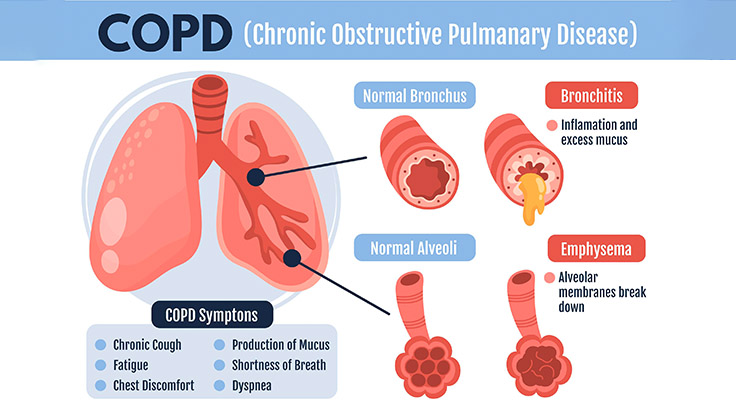Published on:26-09-2023
Do you face breathing difficulty when climbing stairs or running errands? Chronic Obstructive Pulmonary Disease (COPD) is a condition in which you face breathing difficulty. Unfortunately, many Americans suffer from this disease but are not diagnosed yet.
COPD includes emphysema and chronic bronchitis. The first one damages the lungs' alveoli (air sacs), whereas the latter causes inflammation in the airways. Both conditions affect the lungs of the patient. The only difference is in the part of the lung in which the damage occurs. Having COPD means you are having the symptoms of one or both of these lung-related issues.
With time, COPD can progress, making it difficult to breathe. However, understanding the cause, taking the right medications, and bringing lifestyle changes can help you manage COPD.
Causes
One of the most common causes of COPD is smoking. Smoke is an irritant of the airways which causes swelling and triggers inflammation. It can result in the narrowing of the airways, besides affecting the cilia. When cilia get damaged, mucus and other trapped particles in the airways are not removed, resulting in coughing, chest pain, and breathing problems.
Other than smoking, COPD can occur due to some other causes, such as:
- Age over 65
- Exposure to air pollution at home or
work
- Respiratory infections like pneumonia
- Family history
- Alpha-1 antitrypsin deficiency (AAT)
AAT deficiency is the most uncommon cause, which is an inherited disorder. Having this deficiency means your body is not producing enough alpha-1 antitrypsin enzyme. It protects the lungs from the damaging effects of inflammation caused by air pollutants like dust and smoke. When you are deficient in AAT, air pollutants react quickly and cause damage to the lungs.
Symptoms
Some common symptoms of COPD include:
- Persistent cough with mucus
- Wheezing
- Breathing difficulty while doing routine
activities
- Shortness of breath while climbing stairs or
exercising
Diagnosis
For diagnosis, your healthcare provider will take the following steps:
- Medical history
- Physical exam
- Breathing tests
- Blood tests
- Chest x-ray
COPD Management
COPD can range from mild to moderate and even severe. To manage the symptoms, healthcare providers commonly recommend the below practices:
Pulmonary Rehabilitation
Patients get a customized plan to manage COPD that includes lifestyle changes, consumption of a healthy diet, recommended exercise, breathing techniques, etc.
Medications
As per the medical history and the current health condition, doctors prescribe medications to alleviate the symptoms.
Treatment and Prevention of Lung Infection
People with COPD are more likely to get lung infections because of the inability to properly clear the lungs from mucus, dust, and bacteria. Therefore, doctors suggest preventive measures. Some of them include:
- Frequent hand washing
- Avoiding exposure to air pollutants
- Eating a balanced diet
- Staying hydrated
- Keeping breathing equipment clean
Supplemental Oxygen
Some patients need oxygen through oxygen concentrators when their oxygen level is down.
If you are facing the symptoms of COPD, do not delay. Get an appointment at Springfield Medical Clinic to get a suitable treatment.

